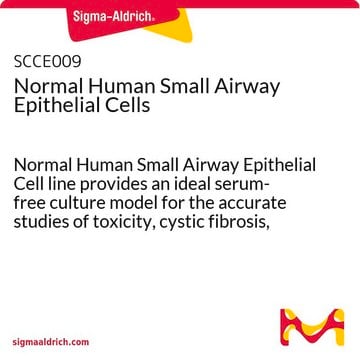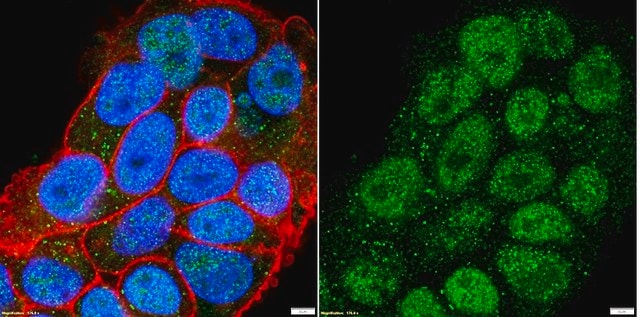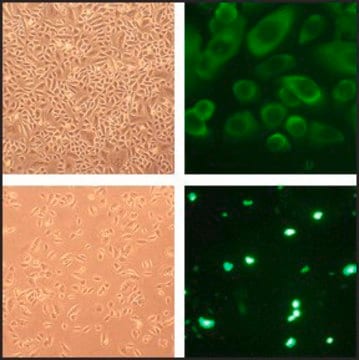C-12642
Human Small Airway Epithelial Cells (HSAEpC)
500,000 cryopreserved cells
Synonim(y):
HSAEpC cells
Zaloguj sięWyświetlanie cen organizacyjnych i kontraktowych
About This Item
Kod UNSPSC:
41106514
NACRES:
NA.81
Polecane produkty
pochodzenie biologiczne
human (bronchiole)
opakowanie
pkg of 500,000 cells
morfologia
(epithelial)
metody
cell culture | mammalian: suitable
powiązane choroby
asthma
Warunki transportu
dry ice
temp. przechowywania
−196°C
Powiązane kategorie
Opis ogólny
Lot specific orders are not able to be placed through the web. Contact your local sales rep for more details.
Human Small Airway Epithelial Cells (HSAEpC) serve as model cell culture systems for in vitro immune response studies. The 3D culture of HSAEpC mimics the in vivo cells effectively. The 3D cells are more viable, functional and efficient for immune response studies compared to the 2D cells.
Human Small Airway Epithelial Cells (HSAEpC) serve as model cell culture systems for in vitro immune response studies. The 3D culture of HSAEpC mimics the in vivo cells effectively. The 3D cells are more viable, functional and efficient for immune response studies compared to the 2D cells.
Primary Human Small Airway Epithelial Cells (HSAEpC) are isolated from the distal portion of the human respiratory tract in the 1 mm bronchiole area and are provided in a cryopreserved format. They stain positive for cytokeratin.The distal respiratory tract mainly consists of pulmonary alveoli, which are spherical outcroppings of the respiratory bronchioles and are the primary sites of gas exchange with the blood. HSAEpC are qualified for functional studies to investigate disorders such as asthma or pulmonary inflammation.
Pochodzenie linii komórkowej
Bronchiole
Zastosowanie
Human Small Airway Epithelial Cells (HSAEpC) may be used:
- in overexpression of αvβ6 integrin
- in cytotoxicity studies with Cannabis sativa oil extract
- in transfection studies with highly pathogenic avian influenza virus and influenza A virus
Jakość
Rigid quality control tests are performed for each lot of Epithelial Cells. They are tested for cell morphology, adherence rate and cell viability. Furthermore, flow cytometric analyses for the cell-type specific marker cytokeratin are carried out for each lot. Growth performance is tested through multiple passages under culture conditions without antibiotics and antimycotics. In addition, all cells have been tested for the absence of HIV-1, HIV-2, HBV, HCV, HTLV-1, HTLV-2 and microbial contaminants (fungi, bacteria, and mycoplasma).
Ostrzeżenie
Although tested negative for HIV-1, HIV-2, HBV, HCV, HTLV-1 and HTLV-2, the cells – like all products of human origin – should be handled as potentially infectious. No test procedure can completely guarantee the absence of infectious agents.
Rutyna subkultury
Click here for more information.
Inne uwagi
Recommended Plating Density: 10000 - 15000 cells per cm2Passage After Thawing: P2Tested Markers: Cytokeratin positiveGuaranteed population doublings: > 15
Polecane produkty
Recommended Primary Cell Culture Media:Link
Oświadczenie o zrzeczeniu się odpowiedzialności
RESEARCH USE ONLY. This product is regulated in France when intended to be used for scientific purposes, including for import and export activities (Article L 1211-1 paragraph 2 of the Public Health Code). The purchaser (i.e. enduser) is required to obtain an import authorization from the France Ministry of Research referred in the Article L1245-5-1 II. of Public Health Code. By ordering this product, you are confirming that you have obtained the proper import authorization.
Kod klasy składowania
12 - Non Combustible Liquids
Klasa zagrożenia wodnego (WGK)
WGK 1
Temperatura zapłonu (°F)
Not applicable
Temperatura zapłonu (°C)
Not applicable
Certyfikaty analizy (CoA)
Poszukaj Certyfikaty analizy (CoA), wpisując numer partii/serii produktów. Numery serii i partii można znaleźć na etykiecie produktu po słowach „seria” lub „partia”.
Masz już ten produkt?
Dokumenty związane z niedawno zakupionymi produktami zostały zamieszczone w Bibliotece dokumentów.
Effects of cannabis oil extract on immune response gene expression in human small airway epithelial cells (HSAEpC): implications for chronic obstructive pulmonary disease (COPD)
Mamber SW, et al.
Journal of Cannabis Research, 2, 5-5 (2020)
Rudra Bhowmick et al.
Tissue engineering. Part A, 24(19-20), 1468-1480 (2018-05-08)
Influenza A virus (IAV) claims ∼250,000-500,000 lives annually worldwide. Currently, there are a few in vitro models available to study IAV immunopathology. Monolayer cultures of cell lines and primary lung cells (two-dimensional [2D] cell culture) is the most commonly used
Swantje Thiele et al.
Cell reports, 31(3), 107549-107549 (2020-04-23)
Importin-α adaptor proteins orchestrate dynamic nuclear transport processes involved in cellular homeostasis. Here, we show that importin-α3, one of the main NF-κB transporters, is the most abundantly expressed classical nuclear transport factor in the mammalian respiratory tract. Importin-α3 promoter activity
Susann Kummer et al.
Viruses, 11(6) (2019-06-20)
Interferon-induced transmembrane proteins (IFITMs) have been shown to strongly affect influenza A virus (IAV) infectivity in tissue culture. Moreover, polymorphisms in IFITM3 have been associated with the severity of the disease in humans. IFITM3 appears to act early in the
Dong-Young Kim et al.
Frontiers in immunology, 11, 68-68 (2020-03-03)
Uncontrolled activation of transforming growth factor (TGF)-β results in a wide range of pathologic conditions. Therapeutic interventions to regulate TGF-β signaling during fibrosis have been developed but the effectiveness is still limited. Here, we show that developmental endothelial locus-1 (Del-1)
Nasz zespół naukowców ma doświadczenie we wszystkich obszarach badań, w tym w naukach przyrodniczych, materiałoznawstwie, syntezie chemicznej, chromatografii, analityce i wielu innych dziedzinach.
Skontaktuj się z zespołem ds. pomocy technicznej








